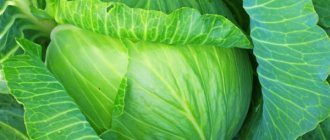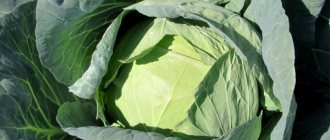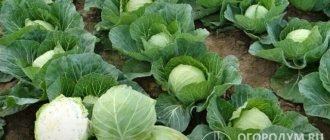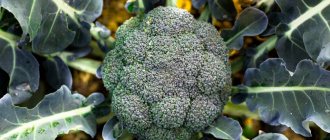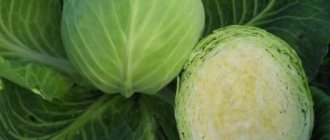Krautkaiser cabbage is a famous variety of white vegetable with very good characteristics. This is a hybrid labeled F1, which is considered high maintenance. But compliance with agrotechnical rules allows you to grow a very high yield of juicy and tasty cabbage. The Latin name of the variety is Brassica Oleracea Var. Capitata 'Krautkaizer F1. Translated from German as Cabbage Monarch.
The hybrid has excellent characteristics, which are fully revealed when agricultural cultivation techniques are followed.
Description of Krautkaiser cabbage
The hybrid cabbage variety was bred by Dutch breeders of the company BEJO ZADEN BV. It grows best in a climate of moderate temperatures. It has been cultivated in the Russian Federation since 1993. Main regions for growing the variety:
- Nizhnevolzhsky;
- Ural;
- Volgo-Vyatsky;
- West Siberian;
- East Siberian;
- Far Eastern;
- Central;
- Northern;
- Northwestern.
The Krautkaiser variety has a lot of useful characteristics, thanks to which it is very popular among vegetable growers.
The ripening period for cabbage is medium-late. The harvest is ready for harvest 100-120 days after planting the seedlings in the ground. In some regions, the ripening period lasts from 125 days to 150 days. This is due to weather conditions.
The plant is powerful and non-lodging. The rosette of the variety is quite large, but compact and sparsely leafy. A distinctive feature of the leaf cover is that cabbage suppresses weeds well, which reduces the number of weedings during the season.
The head of cabbage is of the correct shape. Flat-round or oval shapes may occur. The color of a head of Krautkaiser cabbage when cut is white, the structure is dense and well developed. The plugs are free of voids and filled evenly. The average weight of the heads is 3-4 kg. The inner stalk is of normal length, the outer one is much shorter.
Cabbage leaves are medium sized, semi-raised. Their shape is ovoid, the color is light green, with a slight blue tint.
The amazing color of the leaves adds a decorative touch to Krautkaiser cabbage beds
The surface of the leaves is smooth, with a slight waxy coating, the edges are not wavy. The leaves are juicy and have a pleasant taste.
The Krautkaiser variety is highly adaptable to climate conditions. Grows well in unstable temperatures, tolerates high and low temperatures with equal stability.
If storage requirements are met, Krautkaiser shows average shelf life - up to 4 months. The transportability of the hybrid is excellent and is suitable for mechanical processing.
The variety is grown on an industrial scale.
Description and characteristics
The flexible, high-yielding cabbage variety Krautkaiser belongs to the category of mid-late ripening plants, characterized by powerful growth and the ability to maintain the presentation of heads of cabbage in the field.
Appearance of cabbage
The described hybrid is a fairly powerful, non-lodging plant, which has a large, but at the same time, very compact and sparsely leafed rosette. The heads of cabbage are regular oval or flat-round in shape, with semi-raised leaves of medium size, ovoid, light green in color. The surface of the leaf plates is very smooth, with a characteristic waxy coating of medium intensity. When cut, the color of the head of cabbage is white. The inner stalk is of medium length, the outer one is short. The structure inside the head of cabbage is well developed and dense: the forks are strong, evenly filled, and have virtually no voids.
Did you know? All varieties of cabbage are usually divided into three groups: cabbage, cauliflower and deciduous. Each type has a completely unique composition: the cabbage variety is dominated by vitamins C and K, the colored variety has large amounts of pectin and organic acids, and the leaf variety is rich in mineral salts and essential acids.
The weight of one head varies between 3-4 kg. The taste of cabbage is excellent. The leaves have a high juice content and have a pleasant sweetish taste. The wonderful taste of the vegetable, as well as its juiciness, determine its wide range of applications. It is perfectly relished fresh as part of salads, and is also ideal for pickling, preparing for the winter, and pickling.
Ripening time
The hybrid belongs to the mid-late crops, the fruits of which must be harvested 100–120 days after planting the seedlings. It should be noted that the vegetable reaches technical maturity 110–120 days after the appearance of the first shoots, but after 100 days of growth, the heads of cabbage gain a weight of about 2.5 kg and are ready for harvesting for long-term storage for the winter.
Cabbage is characterized by uniform fruit formation and high yield. All heads of cabbage have a correct, leveled shape and excellent presentation. Under favorable climate conditions and proper care, in one season from 1 sq. m of bed, you can collect about 6–13 kg of fruit. On average, 570–1050 centners of cabbage are obtained from 1 hectare of field. The maximum yield was recorded in the Krasnoyarsk Territory and amounted to 1284 centners per 1 hectare.
What 5 varieties of white cabbage do not have bitterness?
14
2
Resistance to frost and disease
The hybrid has average immunity to various ailments. It has a fairly high resistance to fusarium and spot necrosis, and is relatively resistant to bacteriosis, gray and white rot.
If the rules of agricultural technology are violated and unfavorable climatic conditions, it can be affected by downy mildew, clubroot and viral infections. The hybrid also has an average degree of frost resistance.
Pros and cons of Krautkaiser cabbage
It cannot be said that all vegetable growers like the variety. However, those who grew Krautkaiser highlight a whole list of its advantages:
- Excellent adaptation of cabbage to environmental conditions and climate. Consistently good attitude to heat and cold.
- Heads of cabbage do not crack even with high humidity.
- Large-fruited variety.
- Stable immunity to major crop diseases.
- The density of the heads allows cabbage to be transported over long distances without damage.
- High yield of the variety on different soils.
- Versatility of use.
Some shortcomings are also noted that prevented the Krautkaiser variety from becoming everyone's favorite. They appear only in the presence of violations:
- Agricultural technicians. In this case, the cabbage is affected by a fungal infection - clubroot.
- Storage rules. The shelf life of cabbage, which is already considered average (no more than 4 months), is reduced.
Another disadvantage is the average frost resistance of the variety. It does not allow growing a good harvest in areas with harsh winters.
Advantages and disadvantages
Hybrid Krautkaiser F1 has a number of positive properties:
- tolerates heat and cold well;
- not prone to cracking;
- has immunity to gray and white types of rot, as well as bacteriosis;
- transports well;
- has good shelf life (about 4 months).
Gardeners include the following disadvantages of the crop:
- weak immunity to clubroot;
- the need for regular hydration;
- average level of frost resistance.
Note! A powerful seed bush grows from a head of cabbage planted in spring. However, it will not be possible to collect high-quality seeds from it.
Yield of cabbage Krautkaiser F1
The originators have planned for the high yield of the variety. It is this parameter that attracts farmers. If the requirements of agricultural technology are met and the weather is favorable, then you can harvest 8-13 kg of the Krautkaiser variety from 1 sq. m. Another factor that distinguishes cabbage is the uniform ripening of the forks and excellent presentation.
If you follow all the rules of care, you can reap a large harvest from a small area.
Planting and caring for Krautkaiser cabbage
The description of the variety indicates its heat requirements and average frost resistance. Therefore, Krautkaiser is almost never grown by direct sowing into the ground. The best option is the seedling method. It gives maximum results, although it requires effort. To grow high-quality cabbage seedlings, you need to perform certain actions:
- Purchase certified planting material and prepare it for sowing. The seeds of the Krautkaiser hybrid are characterized by high germination, the first shoots appear 6-7 days after sowing.
- Determine the time for sowing. Krautkaiser cabbage is sown for seedlings in the 2nd decade of April.
- Prepare the seeds. To do this, wrap them in a wet cloth, the temperature of the water for soaking is + 45-50 °C. Leave for 25 minutes, rinse with cold water and place in a stimulating solution for 12 hours. Then you will have to harden it in the refrigerator for 2-3 days. During the day, Krautkaiser seeds are in the room, at night they are sent to the refrigerator
- Prepare the container and soil mixture. It is recommended to take separate cups for sowing. Soil for seedlings can be purchased ready-made or you can mix turf soil with humus in equal quantities yourself. It is useful to add 1 cup of wood ash. Calcine the soil or spill it with a solution of potassium permanganate.
- Fill the cups with a 7 cm layer of soil mixture, bury the cabbage seeds 1.5 cm, and moisten with a spray bottle.
- Cover the crops with film and place them in a warm place with good lighting and an air temperature of at least + 18-23 °C.
- As soon as the seedlings of the Krautkaiser variety hatch, remove the film and reduce the temperature to + 15-18 °C.
As soon as the seedlings hatch, you need to move the container to the light so that they do not stretch out
When caring for seedlings, you need to optimize watering - monitor the level of drying of the top layer of soil. Excessive moistening of Krautkaiser cabbage seedlings will lead to rotting of the stem and root system. To prevent it from stretching, it is necessary to provide good lighting for 14-15 hours. When sowing in a large planting box, be sure to dive the seedlings of the variety. This must be done at the stage of two full leaves, and the seedling should be buried down to the cotyledon leaves. 14 days before planting, begin hardening off the cabbage seedlings by taking the container outside.
Prepare the bed in advance. Krautkaiser cabbage grows well in medium-neutral soil, nutritious and loose. Optimally - black soil or loam. Choose a sunny place, best after potatoes, cucumbers or legumes. Dig up, fill with compost or humus. Cabbage seedlings are ready for planting 35 days after sowing - all of May, depending on the weather and climatic conditions.
Make holes in the garden bed according to the pattern 50×50 cm or 60×40 cm, transfer the seedlings together, cover them with nutritious soil, and water them.
Caring for the Krautkaiser variety is not difficult, but the main points must be followed:
- Watering.
Cabbage is very moisture-loving, so you will have to water the plants all season. Seedlings are moistened 2-3 times a week, taking into account weather conditions. It is important to focus on watering when cabbage heads begin to form. Only with constant soil moisture does Krautkaiser form large heads. But at the moment of their ripening, stop watering so that the heads of cabbage do not crack. Important! When irrigating, avoid getting moisture on the leaves. - Feeding. In early June, Krautkaiser cabbage needs nitrogen, so it is recommended to use an ammonium nitrate solution or an infusion of bird droppings. The second time nutrition is needed is when the heads are formed. The mineral composition is made per 10 liters of water. You will need superphosphate (5 g), urea (4 g), potassium sulfate (8 g). You need to pour 2 liters of the composition onto one plant. A popular recipe is to sprinkle the circle around the trunk with ash.
- Weeding and loosening. They are especially important at the beginning of the growing season so that weeds do not overshadow the Krautkaiser cabbage. Then the variety itself suppresses weeds. Loosening can be continued until the end of the season.
Loosening and weeding significantly improve the quality of the variety's heads - Hilling. This procedure will strengthen the cabbage root system and increase yield. It is more convenient to carry it out after rain. For this variety, hilling is recommended 2 times with an interval of 3 weeks.
The harvest should be harvested on a sunny, dry day. Then sort out the heads of cabbage and send them for storage.
Diseases and pests
Hybrid Krautkaiser has varying degrees of disease resistance. For example, it is not affected by point necrosis and fusarium. But you can get sick with rot (white and gray), clubroot, downy mildew or bacteriosis. This happens when the rules of agricultural technology are violated.
Clubroot is characterized by growths on the roots.
Infection can be prevented by liming the soil
Downy mildew affects not only the leaves, but also other parts of Krautkaiser cabbage.
Bacteriosis makes cabbage unsuitable for use
The most common pests are flea beetles, cabbage flies and aphids.
Pests have to be fought with insecticides
Reviews from summer residents
On specialized forums, gardeners speak positively about the Krautkaiser hybrid:
Vladimir, Voronezh: “For pickling and pickling, I always plant three varieties of cabbage: Krautkaiser, Atria and Krautman. I like them all, but Krautkaiser will benefit from the fact that he is undemanding to the soil, and even fights weeds himself; there is practically no need to weed the ground. I can’t say anything about storage, because I always process the harvest right away - no one in our family eats raw cabbage. But I think that the heads of cabbage will definitely lie in the cellar for six months.”
Valentina, Bryansk: “ I planted Krautkaiser for the first time last year and, compared to other varieties that I grew before, it performed just fine. The productivity is high, the heads of cabbage are very beautiful, juicy and sweet. At the same time, I can’t say that caring for this cabbage is difficult; in general, everything is as usual. I tried fermenting several heads of cabbage and liked the results. Now I will plant more Krautkaiser so that I have enough for fermentation and salting.”
Marina, Krasnoyarsk: “I have no complaints about Krautkaiser - the harvest is rich, the heads of cabbage are large, dense and sweet, they ripen together. If I were to look for shortcomings, I would note that the cabbage is very “sprawly” and takes up a lot of space on the plot.”
